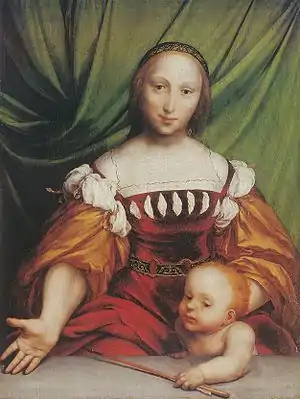Lais of Corinth (Holbein)
Lais of Corinth by Hans Holbein the Younger portrays the famous Lais of Corinth, a courtesan of ancient Greece who charged a high price for her favours. It has been suggested that Holbein is also referring to the Lais who was the lover of Apelles, the great painter of antiquity (Holbein was called "Apelles" in humanist circles). The model, the same used for Holbein's Darmstadt Madonna and for his Venus and Amor, has been identified as Magdalena Offenburg,[1] who may have been Holbein's mistress.


Holbein's Lais was painted a year or two after Venus and Amor and, in effect, acts as its companion piece, though Holbein does not appear to have originally planned the second painting. According to some commentators, the portrayal of the sitter as a hetaera or courtesan may contain a coded message by Holbein about his relationship with her.
Art historian Peter Claussen, however, dismisses this interpretation as "pure nonsense". Both paintings employ the same colours and depict the same costume and drapery. Holbein adopts the style of Leonardo and the Lombard muralists, whose work he may have studied during a visit to Italy. He uses Leonardo's sfumato (smoky) technique to blend the skin tones, as well as the device of the parapet to set the subject back from the viewer.
Notes
- Toman, 382
References
- Buck, 44–43
- Derek Wilson, Hans Holbein: Portrait of an Unknown Man, London: Pimlico, 2006, ISBN 1-84413-918-2, pp. 112–13
- Peter Claussen, "Holbein's Career between City and Court", in Müller, Kemperdick, Ainsworth, et al., Hans Holbein: The Basel Years, 1515–1532, Munich: Prestel, 2006. ISBN 978-3-7913-6052-2. 47
- Buck, Stephanie. Hans Holbein. Cologne: Könemann, 1999, ISBN 3-8290-2583-1.
- Toman, Rolf (ed). Renaissance: Art and Architecture in Europe during the 15th and 16th Centuries. Bath: Parragon, 2009. ISBN 1-4075-5238-4